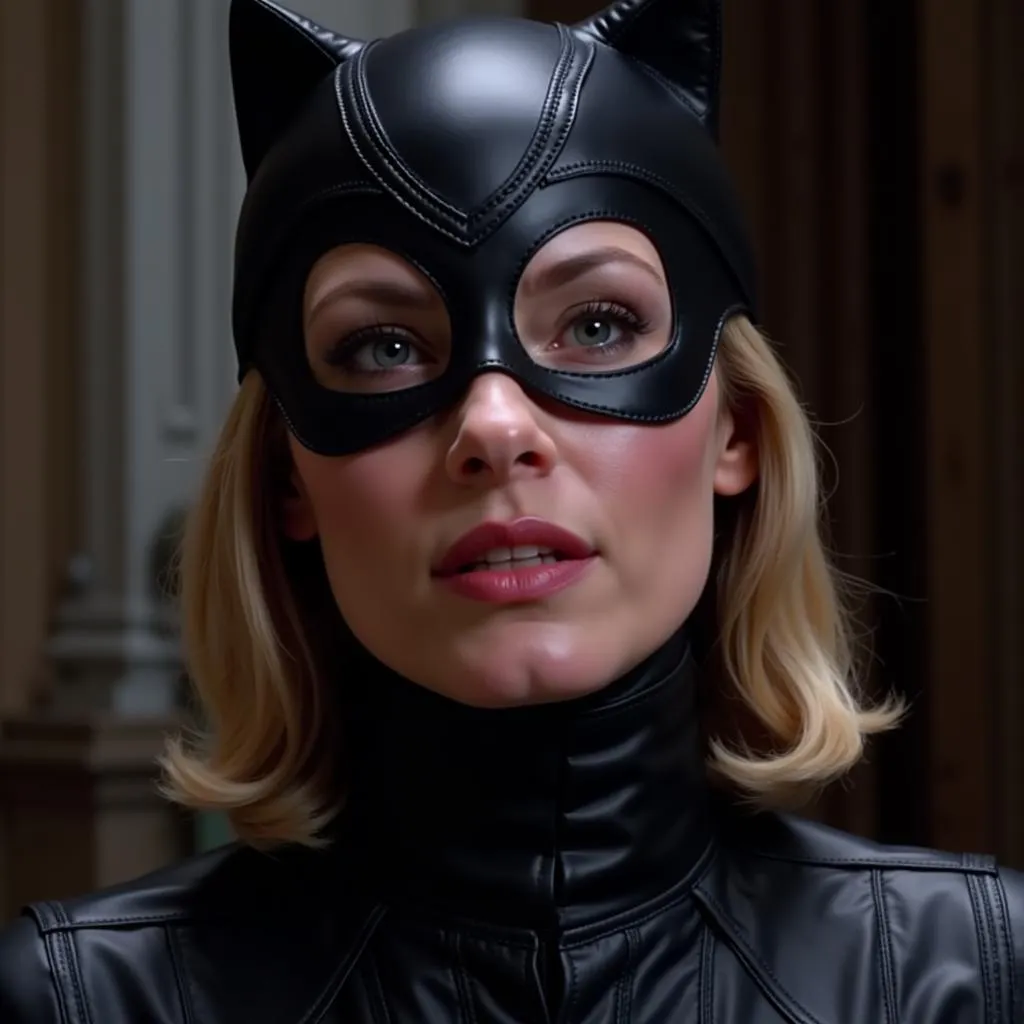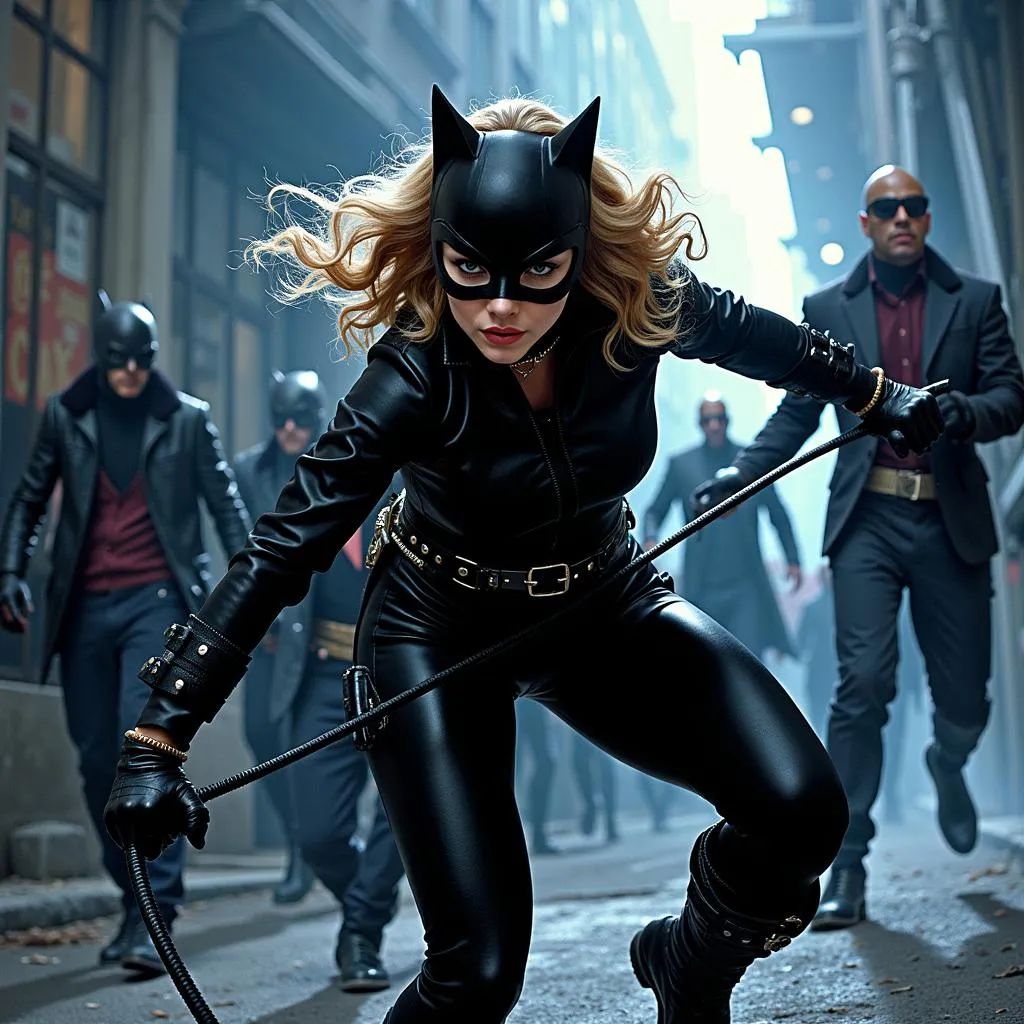Michelle Pfeiffer’s portrayal of Catwoman in Tim Burton’s 1992 film, “Batman Returns,” remains a benchmark in superhero cinema. Even after three decades, her performance as the seductive and vengeful anti-heroine continues to captivate audiences and inspire countless cosplays. But what exactly makes Pfeiffer’s 1993 Catwoman so unforgettable? Let’s delve into the character’s creation, explore the nuances of Pfeiffer’s performance, and uncover why this iteration of Selina Kyle remains the purr-fect embodiment of the feline femme fatale.
From Comic Book Pages to the Silver Screen: The Evolution of Catwoman
Before donning the iconic catsuit, Pfeiffer’s Catwoman underwent a fascinating transformation from her comic book origins. Created by Bill Finger and Bob Kane, Catwoman, initially known as “The Cat,” first graced the pages of Batman #1 in 1940. Over the years, she evolved from a simple jewel thief into a complex anti-heroine, often straddling the line between criminal mastermind and love interest for the Caped Crusader.
 Michelle Pfeiffer in the 1993 Catwoman Costume
Michelle Pfeiffer in the 1993 Catwoman Costume
Pfeiffer’s Catwoman drew inspiration from various comic book storylines, particularly the darker, more psychologically driven narratives of the late 1980s. Tim Burton’s vision for the character leaned into Selina Kyle’s traumatic backstory, emphasizing her transformation from timid secretary to empowered vigilante. This shift in tone resonated with audiences, setting the stage for a Catwoman who was as vulnerable as she was dangerous.
A Star Under Latex: Michelle Pfeiffer’s Transformation into Catwoman
Michelle Pfeiffer’s dedication to the role of Catwoman was evident in her intense preparation. She underwent rigorous physical training, mastering the whip and performing many of her stunts. This commitment to authenticity brought a raw physicality to the character, making her every move both graceful and menacing.
Beyond the physical transformation, Pfeiffer delved deep into Selina’s psyche. Her portrayal perfectly captured the character’s fractured mental state, switching seamlessly between vulnerability, anger, and seductive charm. In one scene, she might be purring playfully with Batman; in another, she unleashes a furious torrent of clawing and whip-cracking on the criminals terrorizing Gotham City. This duality, the constant push and pull between good and evil, made Pfeiffer’s Catwoman a captivating enigma.
Why We’re Still Talking About the 1993 Catwoman
Three decades later, Michelle Pfeiffer’s Catwoman remains a cultural touchstone. Her portrayal resonated not only with comic book fans but also with a wider audience captivated by her blend of strength and vulnerability. Here are some key reasons why:
- Empowerment: Selina Kyle’s transformation from victim to vigilante struck a chord with audiences, particularly women. She represented a powerful figure who refused to be defined by societal expectations or past traumas.
- Complexity: Unlike traditional heroes, Catwoman operates in a moral gray area. Pfeiffer embodied this duality flawlessly, making audiences question whether to root for the anti-heroine or fear her wrath.
- Timeless Appeal: The 1993 Catwoman’s costume, with its sleek black latex and iconic cat-ear cowl, has become instantly recognizable. Its timeless design continues to inspire countless Halloween costumes and fan art.
 Michelle Pfeiffer using her whip as Catwoman in "Batman Returns"
Michelle Pfeiffer using her whip as Catwoman in "Batman Returns"
The Legacy of Pfeiffer’s Performance
Michelle Pfeiffer’s portrayal of Catwoman left an indelible mark on the character’s legacy. Her performance set a high bar for subsequent actresses who took on the role, including Halle Berry and Anne Hathaway. Even today, her performance is celebrated for its nuance, complexity, and enduring appeal.
Pfeiffer’s Catwoman transcended the typical comic book film tropes. She wasn’t just a love interest or a sidekick; she was a force to be reckoned with, a complex character with her own motivations and desires. This depth of characterization, combined with Pfeiffer’s magnetic performance, solidified her place as the definitive Catwoman for a generation of fans.
FAQ: Frequently Asked Questions about 1993 Catwoman
1. Did Michelle Pfeiffer do her own stunts as Catwoman?
Michelle Pfeiffer performed many of her own stunts, including whip training and fight choreography. However, stunt doubles were used for some of the more dangerous scenes.
2. What inspired the design of Catwoman’s costume in “Batman Returns”?
Costume designer Bob Ringwood drew inspiration from fetish wear and the sleek lines of 1950s couture. The result was a costume that was both seductive and functional, perfectly embodying Catwoman’s duality.
3. Will Michelle Pfeiffer ever reprise her role as Catwoman?
While there have been no official announcements, Michelle Pfeiffer has expressed interest in reprising the role, depending on the project.
4. What are some of the most iconic quotes from 1993 Catwoman?
“Meow,” “Life’s a bitch, now so am I,” and “You’re catnip to a girl like me.”
5. How does Michelle Pfeiffer’s Catwoman differ from other iterations of the character?
Pfeiffer’s Catwoman is often praised for her darker, more psychologically complex portrayal. Her tragic backstory and internal struggle with good and evil set her apart from earlier, more comedic interpretations.
Looking for more gaming insights?
Check out these related articles:
- The Evolution of Female Characters in Video Games
- The Enduring Legacy of Classic Arcade Games
- Top 10 Superhero Games of All Time
Get in touch with us:
Phone Number: 0902476650
Email: [email protected]
Address: 139 Đ. Võ Văn Kiệt, Hoà Long, Bà Rịa, Bà Rịa – Vũng Tàu, Việt Nam
Our customer support team is available 24/7 to assist you!





